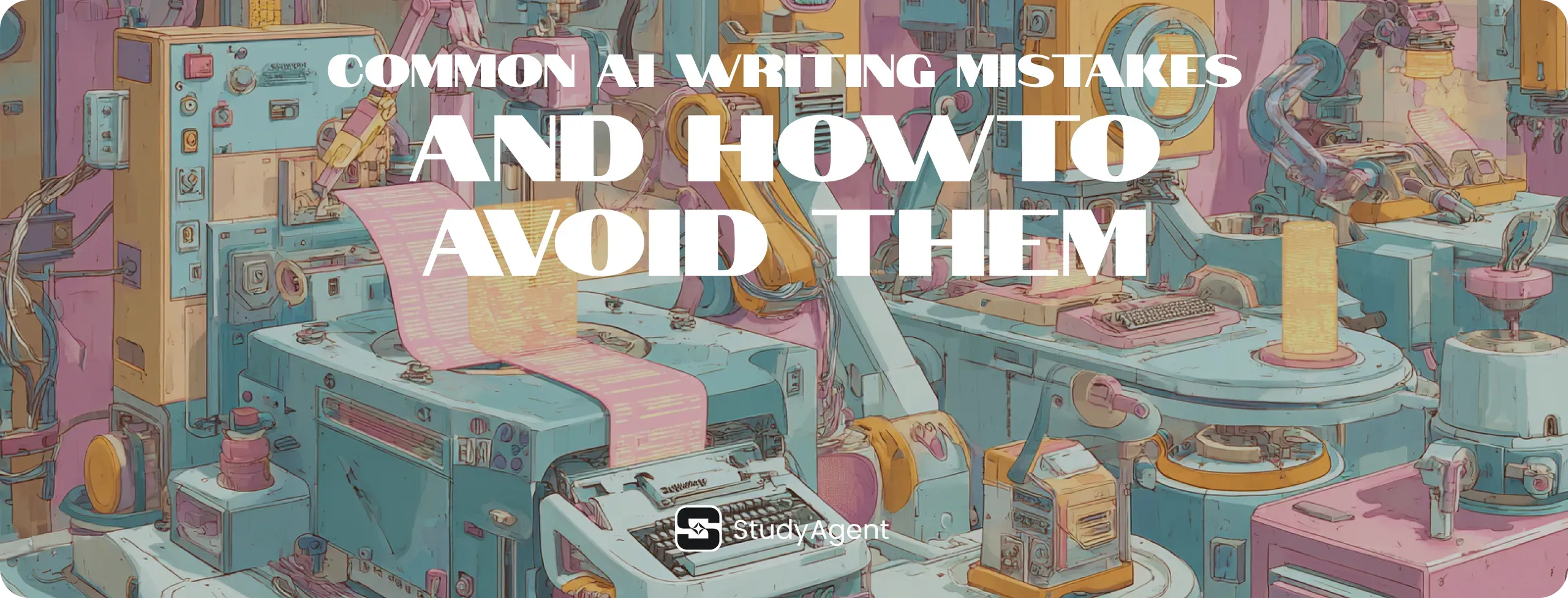Blog>
Common AI Writing Mistakes and How to Avoid Them
Common AI Writing Mistakes and How to Avoid Them
Get acquainted with the 9 most common mistakes AI makes when helping you with content creation. Learn how each one works, how to avoid them, and how to stay clear of AI detection.

Jun 24, 2025

Writing with AI
10 min read

AI makes drafting easier, but it also leaves fingerprints you can easily spot. Overly formal sentences and repeated words are just a few examples of the red flags we often run into. Students must know how to avoid some of the common AI writing mistakes that instantly weaken their papers. This article will point out these flaws and will share tips on how to fix them.
With guidance from StudyAgent and its AI tools, you can draft and polish well-structured papers you’ll be proud to submit.
Common AI Writing Pitfalls Categorized
AI writing tools are prone to error, but which errors do they make the most? Knowing about these mistakes is essential if you want to use AI models. After all, these tools will err. You just have to know how to fix AI writing mistakes, so let us help you.
Here are the most frequent mistakes AI makes:
- Factual mistakes
- Misinterpretation of facts
- Repetition
- Inability to adapt tone
- ‘Robotic’ writing
- Bias
- Lack of nuance
- Punctuation & grammar errors
- Not following instructions
If you want to know how to use AI to write an essay, the answer is simple: beware of the mistakes AI systems tend to make and learn how to fix them.
Lack of Fact-Checking
One of the most dangerous AI myths in education is that AI tools know what they are writing. Any AI, no matter if it’s paid or free, is a language model. A language model predicts the next word depending on the context. It is unable to critically assess information and draw conclusions. It can only repeat what it’s been taught.
If you want to use an AI model for academic writing, you have to stay on top of these AI hallucinations. Fact-check every citation, reference, date, and figure to ensure they are accurate.
Some people are under the impression that if you give it a prompt that says ‘don’t make mistakes,’ it won’t.
But AI is also notorious for not following instructions and presenting incorrect or outdated information. So, if you’re set on the idea of using AI, you have to do the fact-checking.
Misinterpretation of Information
One of the most common mistakes of AI writing is the lack of contextual accuracy. As we’ve already mentioned, artificial intelligence predicts text rather than creates it. When generating content, it can lose track of its own ‘train of thought,’ not to mention long, complex prompts. Did you ever wonder why it doesn’t follow all your instructions? Maybe the prompt was too long and it simply lost track.
AI lacks the ability to recognize context, something that humans do without noticing. For AI-generated text, that means incorrect or outdated information. To mitigate this, you have to remember about this flaw when designing a prompt and, of course, vigorously fact-check the confusing output.
Repetitive Output
The thing about AI writing is that all these mistakes are connected. The lack of contextual understanding leads AI writing tools to generate text that is riddled with factual inaccuracies, poorly interpreted data, and repetition.
AI doesn’t process text as a whole but in a sequence, sentence after sentence. This refers to both input and output. So, when generating text for you, AI can forget it’s already said something. AI tools could write a book about how to make an essay longer, but would anyone read it?
To prevent your text from sounding repetitive and clearly AI-generated, you need to replace redundant phrases with original thoughts. When revising AI-generated text, ask yourself:
- Has that been said before?
- How would I phrase that?
- Does that sentence add value to the overall content?
Inability to Recreate Tone
You might argue that it’s not true – if you tell AI to be friendly, it will use emojis and exclamation points, and if you tell it to be formal, it will avoid colloquial language and contractions. But AI is not human, hence, it doesn’t actually understand what tone of voice is. It lacks the ability to perceive tone and context.
AI also tends to shift its tone while generating content, again, due to poor understanding. Inconsistent tone is one of those AI writing mistakes that can make your professor suspicious you used outside help.
When generating content with artificial intelligence, determine what tone you want the paper to convey and stick to it. When editing yourself or using editing tools, read the text aloud. This will let you actually hear the shift in tone, making proofreading much easier.
Robotic Language
If you read enough AI-generated content, you will probably be able to notice AI writing when you see it. There are common AI writing mistakes, as well as patterns that it tends to use, which make artificially generated text so glaringly obvious.
Here’s what to look for:
- Emotionless text
- Overuse of passive voice
- Repetition in sentence structure, length, beginnings of sentences/paragraphs
- Overused filler and transitional phrases
- Fence-sitting
- Lack of valuable insights
AI text sounds emotionless because it picks neutral words that end up sounding unnatural in human communication. For example, it tends to use ‘individuals’ instead of ‘people,’ ‘utilize’ instead of ‘use,’ etc.
Generative AI relies on transition words and transition phrases to make the text sound coherent, but the text reads as robotic when transitions are overused.
The same goes for passive voice. ‘Balanced’ language, or fence-sitting, is a tactic used by AI to avoid being wrong or offending anyone. These are not common grammar mistakes per se, but lexical and stylistic ones that can give away an AI-generated text without human oversight.
Bias and Ethical Concerns
Bias shows up in AI writing more than most expect. Because the system trains on human data, it can slip into stereotypes or frame examples in ways that tilt toward one group while ignoring another. These aren’t always obvious errors, but in academic or professional contexts, even subtle bias undercuts credibility.
Plagiarism is yet another one of the common mistakes of AI writing. AI doesn’t cite sources, and some sentences end up echoing existing texts too closely. Even when unintentional, it creates problems for originality. That means the responsibility to review and correct sits with the writer.
Practical ways to reduce the risk include:
- Reading drafts with an eye for bias and missing perspectives;
- Running the revised draft through a plagiarism checker;
- Adding clear citations for any borrowed information.
Lack of Contextual Understanding
The inability to read beneath the surface is one of the most common mistakes of AI writing. Processing words doesn’t always mean understanding the intent behind them. For example, it can place a technical phrase in the text. But the placement will be slightly off, and so will be the entire sentence. It also can’t grasp sarcasm or layered humor. This usually results in flat, sometimes even empty, writing.
To fix this, you need to go through your writing paragraph by paragraph and thoroughly test it: are the ideas logically connected, or simply written down? You also need to pay attention to the tone, because AI often slips into casual phrasing. By tightening these elements, the text shifts from machine-like repetition into clear, thoughtful writing.
Punctuation & Grammatical Errors
Grammar mistakes can find their way into your AI-generated text, even though it’s not the most common error. AI writing pitfalls in grammar are tied to the same issues we’ve discussed already – repetition instead of true understanding, mistakes in AI training data, and lags.
AI doesn’t really know grammar. It just mimics the language used in training data. Humans speak differently depending on their background, education, intent, and the situation at hand. AI, on the other hand, is unable to perceive context and adapt appropriately. This may lead to AI using overly complicated language when you ask it to use a formal tone.
- Write a precise and clear prompt
- Set instructions for a specific tone of voice or writing style
- Review the final content
- Break up tasks to ensure content effectiveness
Failure to Follow Instructions
One of the common mistakes of AI writing is its occasional inability to follow guidelines. A prompt may call for a set word count or a specific structure, yet the output doesn’t meet these instructions. The reason for this is simple: AI predicts patterns rather than understanding priorities. As a result, it might “sacrifice” precision.
Many students ask, "How do I use AI without running into this problem?". The answer is simple: stay involved. Review the draft closely against the assignment or brief. Check the length, confirm the structure, and look at whether the tone matches the goal. AI can generate quickly, but only careful human oversight makes sure the instructions are actually met.
Wrapping Up
Nobody can judge you for outsourcing some of your homework to AI writing tools. Being aware of the most common errors when using AI for essays will help you avoid them and get the model to produce usable, relevant content.
Writing clear, precise prompts is the first step. Let’s recap the rest of the tips from this article on content creation with AI:
- Check every piece of information for accuracy
- Speak the tool’s language
- Review content to eliminate repetitive phrases and fillers
- Be on the lookout for bias
- Proofread for grammatical and stylistic errors
- Restart the chat if it starts to forget the initial instructions
Frequently asked questions
When writing AI prompts, avoid making them too long or too vague. Don’t ask too many things in one sentence, and try not to use unclear words. Be specific about what you want the AI to do. Also, avoid giving confusing or mixed instructions. If your prompt is messy, the answer will be too. It’s better to write in clear steps. Always double-check what the AI gives back to make sure it matches what you asked for.
If you submit an essay fully written by an AI tool, your teacher or school may see it as cheating. Many schools use AI detectors, so they might know the work isn’t fully yours. You could lose points or even fail the assignment. Some AI tools also don’t give accurate facts or proper sources, which can hurt your grade. It’s okay to use AI for ideas or help, but always rewrite the content in your own words.
AI-generated content often sounds too perfect or robotic. It may repeat ideas, avoid strong opinions, or use long, formal sentences that don’t match how students usually write. You might also see strange phrases, made-up facts, or sources that don’t exist. Another big sign is when the writing lacks a personal touch or real examples. Teachers can often tell when something doesn’t feel human or natural. That’s why it’s important to edit and add your own voice.


